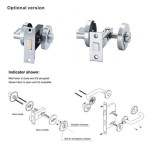Undermount Bathroom Sink: The Round Design and Its Advantages
The undermount bathroom sink, particularly in its round configuration, presents a popular choice for homeowners seeking a blend of modern aesthetics and practical functionality. This design, where the sink is installed beneath the countertop, offers a seamless and streamlined appearance, enhancing the overall visual appeal of the bathroom. The round shape, in particular, brings a softening element to often angular bathroom spaces, contributing to a more inviting and relaxed atmosphere.
The selection of a bathroom sink involves careful consideration of several factors, including material, size, style, and installation type. While drop-in sinks and vessel sinks offer alternative installation methods, the undermount sink distinguishes itself through its clean lines and ease of maintenance. When opting for a round undermount sink, it's crucial to evaluate the countertop material, cabinet dimensions, and desired aesthetic to ensure a cohesive and well-integrated design.
Enhanced Aesthetics and Cleanliness
One of the primary benefits of a round undermount bathroom sink lies in its aesthetic appeal. The absence of a visible lip or rim on the countertop significantly minimizes visual clutter, creating a sleek and modern look. This seamless transition between the countertop and the sink basin allows the countertop material to take center stage, showcasing its beauty and texture. The round shape, with its smooth curves, can also introduce a sense of softness and elegance into the bathroom, contrasting with the sharp angles typically found in fixtures and cabinetry.
Beyond its visual appeal, the undermount design offers practical advantages in terms of cleanliness. The absence of a rim eliminates crevices and edges where dirt, grime, and bacteria can accumulate. This makes cleaning the countertop and sink area significantly easier, requiring only a simple wipe-down to maintain a hygienic surface. The smooth transition between the countertop and the sink prevents water and debris from getting trapped, further simplifying the cleaning process and reducing the risk of mold or mildew growth. This ease of maintenance is especially beneficial in high-traffic bathrooms or for individuals seeking low-maintenance design options.
The choice of material for the round undermount sink also contributes to its overall aesthetic and cleanliness. Common materials include porcelain, ceramic, and cast iron, each offering its own unique properties and visual characteristics. Porcelain and ceramic are known for their durability, stain resistance, and ease of cleaning, making them popular choices for bathroom sinks. Cast iron, often coated with enamel, provides a classic look and exceptional durability. The specific material selected will influence the overall aesthetic of the bathroom and should be chosen in conjunction with the countertop material and other bathroom fixtures.
Optimized Countertop Space and Functionality
The undermount installation method inherently optimizes countertop space, a valuable asset in any bathroom. By mounting the sink beneath the countertop, the surface area remains unobstructed and readily available for toiletries, decorative items, or other bathroom essentials. This is particularly beneficial in smaller bathrooms where countertop space is limited. The clean, uncluttered surface also enhances the overall feeling of spaciousness, making the bathroom feel larger and more organized.
The round shape of the sink further contributes to its functionality. The circular design provides ample basin space for washing hands and other hygiene tasks, while also minimizing the amount of countertop space occupied. The smooth, curved edges of the round sink are also less likely to snag clothing or create sharp corners that could pose a safety hazard. This makes the round undermount sink a practical and user-friendly choice for bathrooms of all sizes.
The integration of the round undermount sink with the countertop is crucial for optimal functionality. The countertop material should be durable, water-resistant, and capable of supporting the weight of the sink and its contents. Common countertop materials include granite, marble, quartz, and solid surface options. Each material offers its own unique aesthetic and performance characteristics, and the selection should be based on personal preferences, budget, and the overall design scheme of the bathroom. The countertop edges should be properly sealed and finished to prevent water damage and ensure a seamless transition to the sink basin.
Considerations for Installation and Compatibility
The installation of a round undermount bathroom sink requires careful planning and execution to ensure a secure and leak-free connection. Proper support is essential to prevent the sink from sagging or detaching from the countertop over time. This typically involves the use of specialized mounting brackets or clips that are securely attached to the underside of the countertop and the sink basin. The weight of the sink and its contents must be evenly distributed to avoid stress on the countertop material.
Compatibility between the sink, countertop, faucet, and drain is paramount for a functional and aesthetically pleasing installation. The faucet selection should complement the style and shape of the sink, and the spout should be positioned to deliver water directly into the center of the basin without splashing. The drain assembly should be properly sealed and connected to the plumbing system to prevent leaks and ensure efficient drainage. The size and placement of the faucet and drain should be carefully considered to ensure they do not interfere with the use of the sink or the surrounding countertop area.
The choice of countertop material also influences the installation process. Some countertop materials, such as granite and quartz, are more difficult to cut and install than others. Professional installation is often recommended for these materials to ensure a clean and precise cut-out for the sink basin. The edges of the cut-out should be properly finished and sealed to prevent water damage and maintain the integrity of the countertop material. The use of appropriate adhesives and sealants is crucial for creating a watertight seal between the sink and the countertop.
Accessibility is another important consideration when installing a round undermount bathroom sink. The height of the countertop and the sink should be appropriate for the intended users, taking into account any mobility limitations or special needs. The placement of the sink should also allow for adequate knee space and maneuverability for individuals using wheelchairs or other assistive devices. Compliance with accessibility guidelines, such as the Americans with Disabilities Act (ADA), may be required in certain settings, such as public restrooms or healthcare facilities.
Ultimately, selecting a round undermount bathroom sink involves a comprehensive evaluation of aesthetic preferences, functional requirements, and installation considerations. By carefully considering these factors, homeowners can create a bathroom space that is both visually appealing and highly practical.

American Imaginations Undermount Bathroom Sink Round Shape 17 In X White Ai 27831 Rona

Ruvati Krona White Ceramic Undermount Round Modern Bathroom Sink 18 5 In X 15 The Sinks Department At Com

Alfi Brand Abc601 White 17 Round Undermount Ceramic Sink

Round Undermount Basin Arto 551 Sink Bathroom

Under Ma 027 By Ws Bath Collections Round Ceramic Undermount Bathroom Sink In Glossy White 17 3 Modo

Undermount Sink Model Ub 03 Blk Badeloft Usa

U2515wh By Rohl Round Undermount Sink White Studio41

K202417 By Kohler Iron Plains 12 Round Drop In Undermount Vessel Bathroom Sink Studio41

Round Stainless Steel Undermount Bathroom Sink In Black Directsinks

Altair 20 In Round Undermount Bathroom Sink White 9003 Bas Wh The Home Depot
Related Posts







